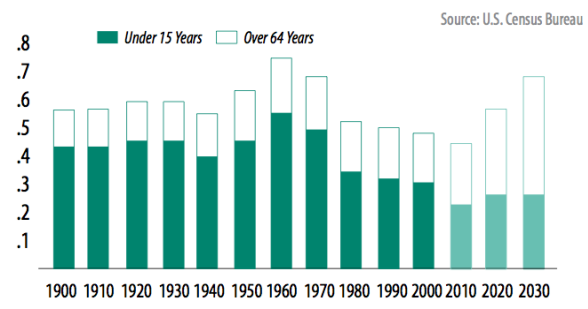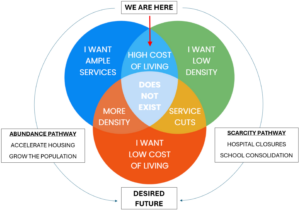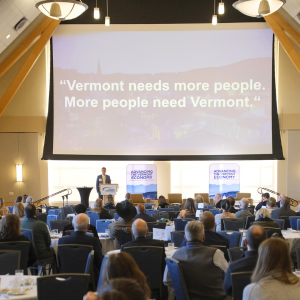This is part three of a four-part series that explores how population changes can impact key aspects of the Vermont economy. In part one and two we discussed the importance of age composition and workforce participation on the Vermont economy. Part three looks deeper into how a changing Age Dependency Ratio may impact the Vermont economy.
Vermont Age Dependency Ratio Trends
The Age Dependency Ratio measures the ratio of the traditional working-age population (age 20 to 64) to the combination of the young (under age 20) and older (over age 64) people. The Age Dependency Ratio is created by dividing the combined populations under 18 and over 64 by the 18-to-64 population. The Age Dependency Ratio serves as a measure of societal economic strain because both younger and older people use more public services such as pensions, health care and education. Essentially, it is a measure of the number of people who are net contributors to public services compared to the number of people who are net beneficiaries. This ratio is a useful indicator of the burden placed on the working age population as it supports the young and old to care for their needs.

As evident in the U.S. Census Bureau chart above, Vermont has had a relatively stable dependency ratio from 1900 to 1950 at just under 60%. This jumped from 1960 to 1970 but then dropped back to about 50% by the 1990’s. In 2010 the Age Dependency Ratio in Vermont rose to 54% while the US average was 59.1%. By 2022 this ratio in Vermont increased to 61%. Projections indicate this ratio will climb back to about 70% by the 2030’s.
Economic Impact
Economists have found Age Dependency Ratios to be a good predictor of economic growth. When ratios are high, a larger percentage of people are out of the work force so there is a smaller percentage of people covering the costs of public services. As Vermonters age and the working population stagnates, the proportion of active wealth producers declines. The elderly often pay lower than average tax revenues when they exit the labor force. This can have a significant impact on the state’s economy and government’s tax collections.
Of course, there are always some exceptions to economic patterns so it would be a mistake to classify everyone over the age of 65 as being dependent on public services. Some people work well into their typical retirement age and some over the age of 19 are not active in the workforce, but broadly speaking, economists have found Age Dependency Ratios to be predictive of economic growth. When ratios are high, you have a high percentage of people out of the work force and a small percentage of people covering the costs of education, retirement, and health care.
In addition, a growing Age Dependency Ratio can create a downward economic spiral, as diminished economic growth then translates to a slower rate of government revenue growth. Due to the increased Age Dependency Ratio, Northwestern University economist Robert J. Gordon estimated that inflation adjusted gross domestic product per capita will decline to an annual rate of 0.9% for the next several decades. A slower rate of economic growth will challenge the sustainability of government programs.
Workforce Impacts
Sandwiched between the young and old is a shrinking percentage of Vermont workers that are in a demographic tug-of-war. As the Age Dependency Ratio increases, Vermont will be forced to juggle competing demands with limited resources. Who will be paying the taxes to maintain public spending on schools, hospitals, courts, jails, and roads? Slower economic growth also means fewer jobs for those working-aged people bearing the primary burden of maintaining the social welfare state through their taxes.
Potential Positive – Civic Engagement
Older populations tend to have higher participation rates in their local communities by voting, helping with non-profits and engaging with other community groups. The age dependency trend might lead to an increase in volunteerism and community involvement. Currently, Vermont ranks 16th in the nation with a 36% volunteer rate. This results in 16.1 million hours of activity that is valued at $390M. Vermont’s older demographic offers a valuable resource to non-profits and local communities in the wake of the declining work force.
The Years Ahead
Every single day between now and 2030, more Vermonters will reach their average retirement age of 65.3 and put more strain on the health care and pension systems. The rate of health care spending increases have exceeded the rate of economic growth for decades now and consumes an ever growing portion of incomes. The slowing of revenue due to the growing Age Dependency Ratio is likely to coincide with dramatic pressure on government budgets. As more Vermonters change from being a net payer into benefits to become a net beneficiary of these programs, there will be many economic decisions to make.
This four-part series is exploring the link between Vermont population change and the economy. In part four, we will discuss how consumption patterns are projected to change as the working age population shrinks in Vermont.



